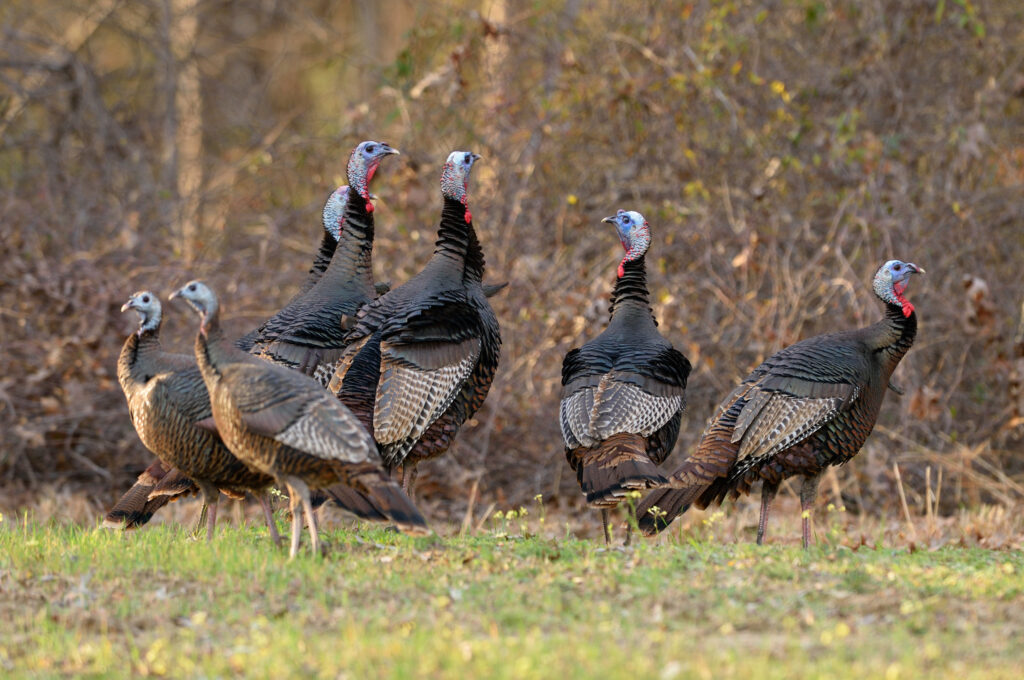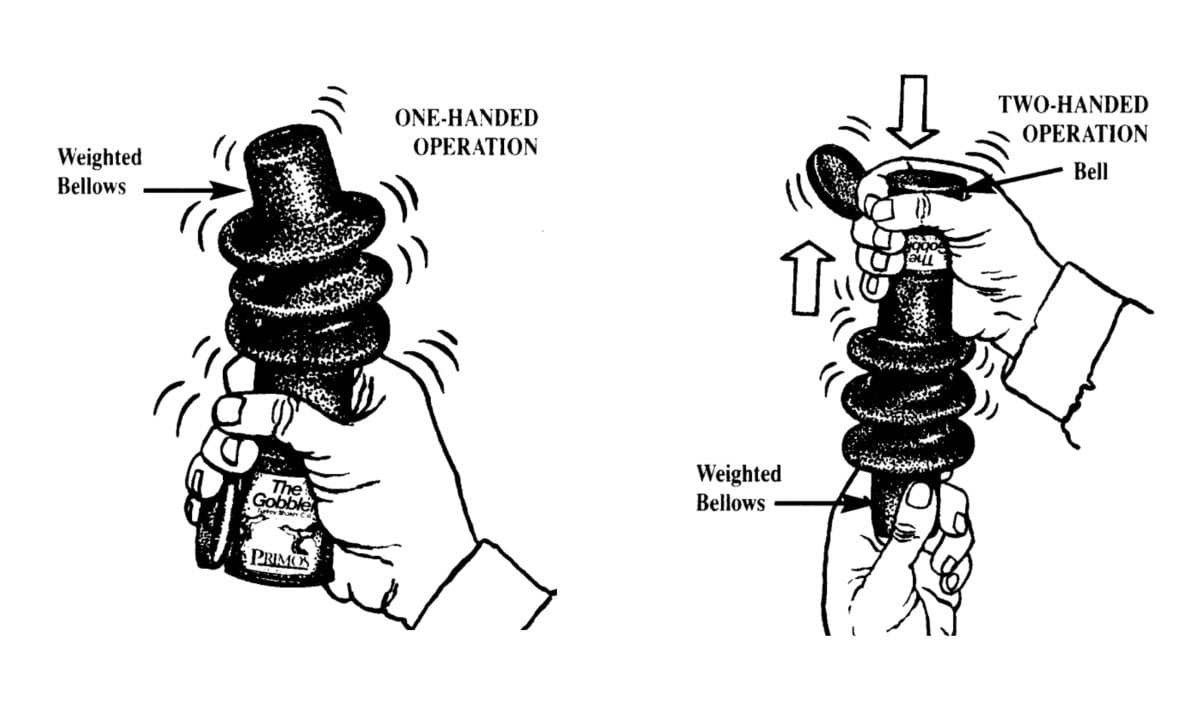
Last Updated on
Turkey hunting is a thrilling experience – every seasoned turkey hunter knows that feeling. One of the most essential tools in their arsenal is the turkey call. But how to choose one and, most importantly, how to use turkey calls correctly? Read on to learn the answers.
Contents
Quick Guide to Wild Turkey Sounds
How to Call Turkey
Best Turkey Calls – Review
Quick Guide to Wild Turkey Sounds

Cluck
The cluck is a short sound that turkeys use as a simple form of communication, often to maintain contact with each other. It often includes two or three single-note clucks. You can use this sound on a gobbler to make an impression of a hen telling she’s waiting for him – it may encourage a gobbler to come closer into your range.
Purr
The purr is a soft, rolling sound turkeys make when they’re content and close together feeding. It’s the turkey version of a cat’s purr, indicating comfort and satisfaction. This is not a soft call, so use it only to reassure turkeys as they get closer to your position.
You can also try using cluck and purr together.
Cutt
The cutt is a loud, fast series of clucks that indicates excitement. Here’s how you can use it. Suppose there’s a gobbler accompanied by hens, and you notice one of the hens cutting. In this case, you can respond with your own cutt to draw her towards you. The trick here is to echo her calls while interjecting your own more excited sounds, cutting off her vocalizations. This may provoke the dominant hen into coming over to confront you, often bringing the gobbler along with her. Plus, if a gobbler is stubbornly unresponsive or ‘hung up’ despite your softer calls, switching to a cutt can be an effective way to get his attention.
Tree Call
The tree call is a series of soft yelps made by a roosted bird, usually just before dawn, to communicate with the others. You can use it to let a roosted gobbler know you are these.
Cackle
The cackle is a series of fast, uneven notes increasing pitch as the call nears its end. Turkeys make it when flying up to a roost or leaving it. Here’s how you can use the cackle call. A fly-down cackle serves as an effective signal to a gobbler that a hen has landed on the ground but this works if the gobbler is already on the ground before you start calling. If not, there’s a chance the tom might stay on the roost, waiting for what he believes is a hen turkey to approach him before he flies down. On the other hand, the fly-up cackle can be handy when you’re trying to locate roosted toms, as it can provoke them to gobble.
Hen Yelp
The plain hen yelp is a basic turkey hunting call that consists of a series of single-note vocalizations. It’s a hen turkey call commonly used to communicate with a gobbler during mating season.
A variation of it is a so-called excited hen yelp, a more excited, rapid, and loud turkey call sound. It doesn’t signal danger but suggests that a female turkey is enthusiastic about something. If you encounter a henned-up gobbler, you might be able to lure him over by engaging the dominant hen in a vocal argument. Just like when using cutts, respond to her with your own excited yelps, interrupting her calls with yours to provoke her. This tactic could potentially attract both the hen and the gobbler towards you. Additionally, if a gobbler remains unresponsive despite your softer calls, switching to an excited yelp can help draw his attention.
Gobble
The turkey gobble call is a loud, rapid gurgling sound made by male turkeys to attract females and proclaim their territory in the spring. Use turkey gobble call carefully because you may draw a dominant tom looking for a fight or spook off less dominant gobblers who want to avoid it.
Assembly Call
An assembly call is a female turkey call that consists of a long series of loud yelps. It’s made by a hen turkey to assemble her scattered flock or young poults together. You’ll often hear it during the fall.
Kee Kee Run
The kee kee run is a three-note call made by young turkeys in the fall when they’re trying to regroup after being scattered, but variations of it can be made by adult turkeys. You can also try using the kee kee run call during the spring.
Putt
The putt is a sharp, loud note that turkeys make when they’re alarmed, but you can use it to your advantage. Make this call when you want a gobbler to stop and raise his head for a shot, but make sure your weapon is ready on target.
Crow Call & Owl Hoot
The crow call and owl hoot are sounds made by other birds, but turkeys often respond to these calls. The crow call consisting of several “caw” notes is effective at any time except sunrise and sunset, while the hoot consisting of eight notes having a cadence of “who cooks for you, who cooks for you-all”) is effective during early morning or late evening. These calls can be used by hunters to locate turkeys. But use them correctly.
An owl hoot might cause the gobbler to look for you before you’re ready and keep.
And when using the crow call, keep it short.
How to Call Turkey

The spring turkey season is characterized by breeding activity, making it a fantastic time for hunters. During this period, gobblers are incredibly vocal as they strut around trying to attract hens, making it the perfect time for using turkey mating calls, such as yelps, clucks, and gobbles.
During the fall turkey season, turkeys flock together and focus on feeding. Young turkeys, or jakes, make a unique sound known as a ‘kee-kee run‘ when they’re separated from their flock. Using a kee-kee call can imitate a lost young turkey and draw in other turkeys looking to regroup. On the other hand, a hen makes an assembly call, the sound of a hen gathering her brood.
Best Turkey Calls – Review
The primary types of turkey calls are box calls, slate calls, diaphragm calls, and reed-type locator calls. Box calls are great for beginners due to their ease of use, while slate calls offer a wide range of sounds, including yelps, clucks, and purrs. Diaphragm calls require some practice but allow hands-free operation essential for those critical moments when a gobbler is approaching. Locator calls are hand-held reed calls used to shock a turkey.
PRIMOS The Gobbler “Shaker Call”
This versatile call is designed to be operated with one or two hands. A two-handed operation can imitate the sound of a mature gobbler, which can attract a dominant tom to the area, while a one-hand operation produces the sound of a young jake. Here’s how to use the Primos Shaker Call:

PRIMOS Turkey Starter Pak
This turkey call starter pack is an excellent choice for beginners. This pack includes four calls, giving newcomers a chance to try out different types and find what works best for them.
PRIMOS Power Crystal Turkey Call
This friction call boasts superior volume and range. Its crystal surface excels at high-pitched, raspy yelps and cuts that can reach out to long-distance turkeys.
WOODHAVEN Legend Slate Friction Turkey Call
This one is renowned for its realistic, soft, and subtle turkey sounds. It’s perfect for close encounters when you need to sweet-talk a turkey into your range.
WOODHAVEN Anodized Ninja Friction Turkey Call
This versatile friction call uses an anodized aluminum surface to deliver unique tones, from soft purrs to loud yelps.
WOODHAVEN Ninja Hen Box Turkey Call
Here we have a wild turkey call that combines the simplicity of a box call with the versatility to produce soft and loud calling. Whether you need to cluck, purr, or yelp, this call has got you covered.
WOODHAVEN Toxic Orange Mouth Turkey Call
This one here is created to mimic the sound of a young hen and kee-kee runs and can be incredibly effective during the fall season.
WOODHAVEN Top 3 ProPack Mouth Turkey Call
This pack includes three mouth calls that produce different turkey sounds. These calls can be used to simulate various hen sounds, which can bring in toms.
PRIMOS Power Owl Turkey Call
This Primos turkey call is a locator type used to shock gobblers into revealing their location. It replicates the hoots of an owl, which can elicit a shock gobble, particularly during early morning or late evening.
PRIMOS Crow Turkey Locator Call
If you’re hunting during the day and want to use a locator call, this Primos turkey call for imitating the sound of a crow is just perfect. It can be used to provoke a shock gobble from a tom at any time of day, except for sunrise and sunset.
These calls are just a few examples of the many turkey calls available on the market. To be successful in turkey hunting, it is important to experiment with different calls and techniques to find what works best for you.
Read other posts:
Mastering the Art of Using Game Calls: Part 1 – Deer Calls
Mastering the Art of Using Game Calls: Part 2 – Elk Calls
Mastering the Art of Using Game Calls: Part 4 – Duck Calls
Mastering the Art of Using Game Calls: Part 5 – Coyote Calls
FAQ
What are male turkeys called?
Male turkeys are called “toms” or “gobblers.”
What sound does a turkey make?
Turkeys make a variety of sounds, including gobbles, clucks, purrs, and yelps. The most well-known turkey sound is the gobble, which is made by male turkeys during mating season to attract females and intimidate competing males.
What does a hen turkey sound like?
Hen turkeys make clucks and purrs to communicate with other turkeys. Hen mating calls are yelps. Cutt, a sound of excitement, is used by a dominant hen when accompanied by a gobbler. Assembly call is used during the fall to assemble a scattered flock.
Do female turkeys gobble?
Female turkeys also gobble but they typically make other vocalizations such as clucking, purring, and yelping. Male turkeys, known as gobblers or toms, make the most well-known turkey sound, the gobble, to attract females and establish dominance over other males.
Why do turkeys gobble?
Male turkeys gobble during mating season to attract females and establish dominance over other males. Gobbling is also used as a way of communication with other turkeys in the area.




Leave a Reply